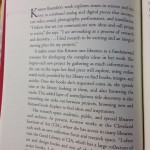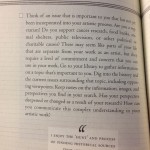This spring I was able to attend an amazing lecture by Ricardo Salvador called, “Fooling the Nine Billion: Why We Need Good Food, Not More Food.” Salvador is the senior scientist and director of the Food & Environment Program at the Union of Concerned Scientists. This group is working with citizens, scientists, economists, and politicians to transition our current food system into one that grows healthy foods while employing sustainable practices.
His lecture gave an overview of the history of our food system in the U.S., the role of government and citizens in this system, and talked about how our current system was a vision or project that came into fulfillment. It was one of the best presentations I have seen in quite a while. Savador was a dynamic speaker, and had not just slides but animations that supported what he was presenting.
He began by talking about how we experience the system by eating out (and imagining what we want to have) and usually getting what we want in 5-20 minutes, whether it is season or not, or local or not. We also go to the super market and browse over 50,000 items and ususally use the criteria of choosing things that we can try to assemble into a meal in 5-20 minutes. Behind this is a system with great power which uses materials and energy.
“The Future of Food is a question that can be approached using direction and prediction, but it is up to people to decide what the future of the food system will be,” he stated in his introduction. He went on in his talk to talk about the history of our food system, the overproduction of food and how this is used and how our system is supporting diabetes and obesity. “Diabetes – has a public cost of 92 billion, Obesity $147 billion, Cardiovascular Disease – $444 billion and is the #1 killer. We pay for the production and cost of this disease
He then had images and a recent example of the price of purchasing traditional versus healthy food at McDonald’s which showed how our current food system makes it so it is not possible for McDonald’s to offer the healthier choices at a equal price. The healthy foods also do not add up to many calories.
The last part of his lecture called for a shift in our food system, and he mentioned a current project called “An Apple a Day” – which is a education and advocating for how our current food system is wasting government money, wasting lives, and wasting medical costs. Promoting the food problem as a system that is wasting government money, wasting lives, and wasting medical costs is something that can go across government parties.
I recently got the link of Recardo’s recorded lecture which can be seen online. It is good quality audio and video – and I strongly recommend that you watch it to get a new perspective on our food system and the future of food (and you can eat an apple while you watch.)
Image Sources and Links:
Ricardo Salvado – Watch the Lecture Fooling the Nine Billion – Video


